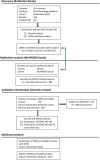CDH6 and HAGH protein levels in plasma associate with Alzheimer's disease in APOE ε4 carriers
- PMID: 32427856
- PMCID: PMC7237496
- DOI: 10.1038/s41598-020-65038-5
CDH6 and HAGH protein levels in plasma associate with Alzheimer's disease in APOE ε4 carriers
Abstract
Many Alzheimer's disease (AD) genes including Apolipoprotein E (APOE) are found to be expressed in blood-derived macrophages and thus may alter blood protein levels. We measured 91 neuro-proteins in plasma from 316 participants of the Rotterdam Study (incident AD = 161) using Proximity Extension Ligation assay. We studied the association of plasma proteins with AD in the overall sample and stratified by APOE. Findings from the Rotterdam study were replicated in 186 AD patients of the BioFINDER study. We further evaluated the correlation of these protein biomarkers with total tau (t-tau), phosphorylated tau (p-tau) and amyloid-beta (Aβ) 42 levels in cerebrospinal fluid (CSF) in the Amsterdam Dementia Cohort (N = 441). Finally, we conducted a genome-wide association study (GWAS) to identify the genetic variants determining the blood levels of AD-associated proteins. Plasma levels of the proteins, CDH6 (β = 0.638, P = 3.33 × 10-4) and HAGH (β = 0.481, P = 7.20 × 10-4), were significantly elevated in APOE ε4 carrier AD patients. The findings in the Rotterdam Study were replicated in the BioFINDER study for both CDH6 (β = 1.365, P = 3.97 × 10-3) and HAGH proteins (β = 0.506, P = 9.31 × 10-7) when comparing cases and controls in APOE ε4 carriers. In the CSF, CDH6 levels were positively correlated with t-tau and p-tau in the total sample as well as in APOE ε4 stratum (P < 1 × 10-3). The HAGH protein was not detected in CSF. GWAS of plasma CDH6 protein levels showed significant association with a cis-regulatory locus (rs111283466, P = 1.92 × 10-9). CDH6 protein is implicated in cell adhesion and synaptogenesis while HAGH protein is related to the oxidative stress pathway. Our findings suggest that these pathways may be altered during presymptomatic AD and that CDH6 and HAGH may be new blood-based biomarkers.
Conflict of interest statement
S.A., M.C.M., A.D., R.A., M.E.S., A.R., T.H., E.S., N.M., P.S., M.A.I., N.A., C.M.D. declare no competing interests. O.H. has acquired research support (for the institution) from Roche, Pfizer, GE Healthcare, Biogen, AVID Radiopharmaceuticals and Euroimmun. In the past 2 years, O.H. has received consultancy/speaker fees (paid to the institution) from Biogen and Roche. Dr. Nikolaos Giagtzoglou was an employee at Biogen Idec, USA. Dr. Alfredo Cabrera-Socorro is an employee of Janssen Pharmaceutical NV, Turnhoutseweg 30, 2340 Beerse, Belgium. Dr. Margot H.M. Bakker is a full time employee of AbbVie GmbH & Co KG and owns AbbVie stock. AbbVie contributed to the study design, research, and interpretation of data, reviewing, and approving the publication. Prof. dr. Teunissen has functioned in advisory boards of Roche, received non-financial support in the form of research consumables from ADxNeurosciences and Euroimmun, performed contract research or received grants from Probiodrug, Biogen, Esai, Toyama, Janssen prevention center, Boehringer, AxonNeurosciences, EIP farma, PeopleBio, Roche.Research programs of Prof. dr. Wiesje van der Flier have been funded by ZonMW, NWO, EU-FP7, Alzheimer Nederland, CardioVascular Onderzoek Nederland, stichting Dioraphte, Gieskes-Strijbis fonds, Pasman stichting, Biogen MA Inc, Boehringer Ingelheim, Piramal Neuroimaging, Roche BV, Janssen Stellar, Combinostics. WF holds the Pasman chair. WF has performed contract research for Biogen MA Inc and Boehringer Ingelheim. WF has been an invited speaker at Boehringer Ingelheim and Biogen MA Inc. All funding is paid to her institution.
Figures




References
Publication types
MeSH terms
Substances
LinkOut - more resources
Full Text Sources
Medical
Molecular Biology Databases
Miscellaneous

